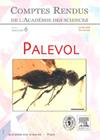澳大利亚昆士兰Tournaisian的新Pitus和eristophyl型木材:分类、生物地理和古气候意义
IF 1.3
4区 地球科学
Q3 PALEONTOLOGY
引用次数: 0
摘要
树状木本植物的化石记录显示,在图尔奈世(360-347亿a)期间,植物的解剖多样性不断增加,这表明在1871年泥盆纪-石炭纪边界的前裸子植物Archaeopteris Dawson灭绝之后,植物的形态-解剖多样性开始增加。这种观点部分建立在最近对澳大利亚东部早石炭世矿床的调查上。在本文中,我们描述了来自澳大利亚昆士兰州东北部Burdekin盆地Tournaisian的新硅化木遗骸,它们在解剖学上与Pitus Zalessky属(1911)和Eristophyton Gordon属(1935)接近。虽然不确定,但这些木材遗骸的分类亲和力对未来早石炭世乔木植物的研究具有若干意义。首先,内生植物和松属的分类学问题越来越大,因为将化石木材分配给这些属的报道已经超出了月桂属。其次,东冈瓦南和Laurussian的植物区系从泥盆纪开始呈现出一种趋同的多样化模式,早石炭世可能出现了多种木本植物。第三,在木材解剖和离散年轮方面,Laurussia和Australia之间的辐合可能与早石炭世季风环流的过去建议一致。本文章由计算机程序翻译,如有差异,请以英文原文为准。
New Pitus and Eristophyton-type woods from the Tournaisian of Queensland, Australia: taxonomic, biogeographic, and palaeoclimatic implications
The fossil record of arborescent lignophytes shows an increasing anatomical diversity during the Tournaisian (360-347 Mya), suggesting a morpho-anatomical diversification following the extinction of the progymnosperm Archaeopteris Dawson, 1871 at the Devonian-Carboniferous boundary. This view has been partly constructed on recent investigations of Early Carboniferous deposits in eastern Australia. In this paper, we describe new silicified wood remains from the Tournaisian of the Burdekin Basin, northeastern Queensland, Australia, that are anatomically close to the genera Pitus Zalessky, 1911 and Eristophyton Gordon, 1935. While uncertain, the taxonomic affinities of these wood remains have several implications for future studies of Early Carboniferous arborescent lignophytes. First, the taxonomy of Eristophyton and Pitus has become increasingly problematic as reports of fossil wood assigned to these genera have extended beyond Laurussia. Second, Eastern Gondwanan and Laurussian floras display a convergent pattern of diversification from the Devonian, with the probable presence of a diversity of lignophyte trees in the Early Carboniferous. Third, convergence between Laurussia and Australia with respect to wood anatomy and discrete growth rings may be consistent with past suggestions of a monsoonal circulation during the Early Carboniferous.
求助全文
通过发布文献求助,成功后即可免费获取论文全文。
去求助
来源期刊

Comptes Rendus Palevol
地学-古生物学
CiteScore
2.10
自引率
0.00%
发文量
39
审稿时长
17.6 weeks
期刊介绍:
Comptes Rendus Palevol is a fully electronic and peer-reviewed journal, with a continuous publication stream, devoted to palaeontology, prehistory and evolutionary sciences. It publishes original research results, in French or English, in the following domains: systematic and human palaeontology, prehistory, evolutionary biology and macroevolution, and history of sciences. Thematic issues may also be published under the responsibility of a guest editor. All articles published in Comptes Rendus Palevol are compliant with the different nomenclatural codes. A copyright assignment will be signed by the authors before publication.
 求助内容:
求助内容: 应助结果提醒方式:
应助结果提醒方式:


